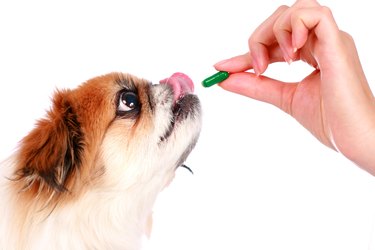Side Effects of Glucosamine for a Dog
Glucosamine is used to improve the quality of life for dogs with canine osteoarthritis. Dr. Shagufta Mulla, a veterinarian with a DVM degree from Colorado State University with 20 years of experience as a small animal veterinarian, told us that his shellfish derivative has the benefit of being inexpensive and readily available. Its many forms make it convenient to administer to different breeds of dogs. In addition, giving dietary supplements of glucosamine for dogs has a relatively small number of side effects, all of which are easily treatable. As a result, glucosamine is thought to be a safe and convenient treatment for osteoarthritis in dogs.

Video of the Day
Facts about glucosamine for dogs
Glucosamine is a naturally occurring substance found in joint cartilage. As the body ages, the production of glucosamine decreases, and joint disease like canine osteoarthritis may occur. Glucosamine used in over-the-counter supplements is found in crustacean shells in a substance called "chitin." Since shells are typically discarded, they are fortunately plentiful and easy to harvest for use in glucosamine supplements.
Video of the Day
Canine osteoarthritis symptoms include difficulty walking, lethargy, or difficulty getting up from a sitting position. "Also look for trouble getting onto the couch or bed or into the car, stiffness that worsens with cold weather, and a lack of desire to be touched," says Dr. Mulla. When you see these joint pain symptoms in your dog's body, they should be taken to the veterinarian to rule out arthritis or other joint issues or injuries.
Pet parents must continue to give glucosamine and chondroitin, glucosamine sulfate, or glucosamine hydrochloride all of their dog's life in order for the relief they experience to continue. The words "glucosamine and chondroitin" are often used together but they are separate things. "They're two separate ingredients, usually in one joint product," explains Dr. Mulla. "Sometimes a bottle label will have these two words without 'and' on the front." Pet Glucosamine supplements do not cure any effects of arthritis or restore healthy joints or joint function; they merely return the level of glucosamine in the body to approach what was formerly normal.
"However, there is a dog product related to glucosamine that actually treats canine arthritis instead of just managing clinical signs," says Dr. Mulla. "It's an FDA-approved injectable drug called Adequan. Unlike joint supplements, Adequan actually prevents the progression of structural changes in your dog's joints affected by arthritis, though it doesn't cure arthritis. It's most effective when used early on in arthritis before a lot of joint damage has occurred."
Glucosamine therapy is commonly used in Europe. It has grown in popularity in North America. Veterinarians commonly prescribe such therapy as well as other nutritional supplements for their patients. "Glucosamine therapy is popular now and very likely to be recommended," says Dr. Mulla. "There are a variety of formulations available too, like flavored chews, liquids, and powders. Several pet food manufacturers now make joint health dog foods, some of which contain glucosamine and other ingredients to support joint health."

Few side effects occur when treating a dog with glucosamine. With rare exceptions, they are mild and easy to treat. Mild side effects of glucosamine for dogs include vomiting, abnormal stool production (either diarrhea or constipation), and drowsiness, among others. "These side effects are generally minimized or alleviated if the supplement is given with food," says Dr. Mulla. Severe side effects include allergic reactions if the dog is allergic to shellfish, a blood-thinning effect if the glucosamine is paired with chondroitin, or heightened blood sugar levels.
Symptoms of an allergic reaction (or specifically, a shellfish or crustacean allergy) may be as mild as the dog chewing at their feet or as severe as anaphylactic shock. Anaphylactic shock requires treatment by a veterinarian. Do not give your dog human glucosamine or use other supplements intended for humans as dog joint supplements without speaking to your dog's veterinarian. As with most supplements and medications, too much glucosamine for dogs can lead to toxicity, so be sure to stick to the amount your veterinarian indicates. But it takes a lot to be toxic, points out Dr. Mulla. For example, a study reported a Bernese mountain dog who ate about 200 tablets and developed liver toxicity.

Does glucosamine for dogs have other side effects?
In addition to allergy issues, dogs can exhibit excessive urination, insomnia, and lethargy. Decreasing the side effects of glucosamine for dogs may be as simple as reducing the amount being given or giving the supplement with food. Dogs beginning glucosamine treatment may initially require high doses of the supplement for it to have any positive effect.
The loading dose, as it's called, typically lasts four to six weeks. However, some dogs respond sooner and can be switched to the maintenance dose earlier. Dogs who experience symptoms such as reduced appetite or gastrointestinal complications may find them lessened when the dosage is reduced. Glucosamine made from corn or other plant products is available for dogs who have shellfish allergies; however, this kind of glucosamine is more difficult to find than the shellfish product.
"Talk to your veterinarian to see if you need to adjust the dose of any of your dog's arthritis pain medication," says Dr. Mulla. "If your pet has a sensitive digestive tract, your veterinarian may have you temporarily decrease, or temporarily discontinue, other medications that the dog is taking when starting a glucosamine regimen in order to avoid potential complications."
The bottom line
Glucosamine chondroitin supplements are used for dogs with canine osteoarthritis or similar joint problems. Some dogs may experience side effects and allergic reactions, but overall, any side effects of glucosamine should be minimal and easy to correct. Your DVM is the most authoritative source when it comes to determining what type of glucosamine supplements you should consider for your dog's health, and how often you should administer them.
- Adequan Canine: Home
- American Kennel Club: Can Glucosamine for Dogs Help Treat Arthritis and Joint Pain?
- The Canadian Veterinary Journal: Multiorgan Dysfunction Syndrome Secondary to Joint Supplement Overdosage in a Dog
- Open Veterinary Journal: Glucosamine and Chondroitin Use in Canines for Osteoarthritis: A Review